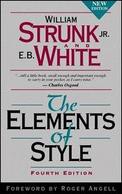I've heard for years that I should read this short book, that it's a must for any writer and one of the best explanations of the basic rules of English ever written. I've been resisting for the reasons one resists eating spinach. I enjoyed grammar in high school and read several books of grammar rules, and after studying it for long enough it all looks the same.
So much for that expectation. If you've been avoiding this based on the same concern, I recommend finding a copy. Not only is this book informative even if you already know grammar well, it's wonderfully entertaining.
The original Elements of Style was a textbook written by William Strunk Jr. for his Cornell English class. It contains eight rules of usage, ten rules of composition, some notes on miscellaneous matters of form in writing (such as headings, numerals, and quotations), and lists of commonly misused and misspelled words. It was a sparse forty-three pages. This version is now out of copyright and readily available on-line, although English has changed and at times it is now inaccurate ("to-day" and "any body" are now incorrect). In 1957, after Strunk's death, it was extensively revised by his former student E.B. White, best known today for his children's books (including Charlotte's Web) but also a regular columnist for The New Yorker and other magazines and a winner of the Pulitzer Prize. White expanded the original sections and added an additional section on style. This is the version printed today; the fourth edition also has a forward, an introduction by White, an afterword, and a very useful glossary.
The first section on basic grammar rules is the most susceptible to the English textbook problem. There aren't many ways to describe restrictive clauses, correct formation of the possessive, and subject-verb agreement. I also had minor quibbles with the method of presentation and the terms used, which I think date both from the age of the original and the desire to be brief. For example, numerous concepts are mixed together under the label "parenthetic," where I prefer distinguishing between (at least) interjections and non-restrictive clauses and find the dichotomy between restrictive and non-restrictive more familiar. But the writing is clear and concise, every rule has examples, and there is an excellent section on the proper use of colons (English's forgotten punctuation mark).
It is with the second section that The Elements of Style leaves ground well-trod by grammar texts and becomes a work of art. The discussions of sentence structure and parallelism are the best I've read. Even better, the rules are forceful, clear, and written with an elegance of language that serves as the best illustration of the principles of the book. "Make definite assertions. Avoid tame, colorless, hesitating, noncommittal language. Use the word not as a means of denial or in antithesis, never as a means of evasion." The phrasing brings clarity to flaws in writing in a way that seems natural but that other works don't achieve, and it's a delight to read firm opinions stated effectively.
The section on misused words and expressions sounds like a boring laundry list and is anything but. It is not only a fount of fascinating word-use trivia (although a few are obsolete; "data" is now firmly established as a mass noun used with singular verbs) but also home to some of the best pointed barbs in the book. An example:
Flammable. An oddity, chiefly useful in saving lives. The common word meaning "combustible" is inflammable. But some people are thrown off by the in- and think inflammable means "not combustible." For this reason, trucks carrying gasoline or explosives are now marked FLAMMABLE. Unless you are operating such a truck and hence are concerned with the safety of children and illiterates, use inflammable.
There are many entries like this. This section had me laughing out-loud in delight and is well worth reading for pure entertainment. Despite its prosaic appearance, it is the best section of the book.
That honor is debatable, and its closest challenger is the next, White's addition on style. White offers both an elegant and memorable summary of the basics of style and exceptionally beautiful writing to convey it. It's one thing to be told to avoid qualifiers. It's quite another to read "Rather, very, little, pretty — these are the leeches that infest the pond of prose, sucking the blood of words." One section was so pointedly accurate that I should print it out and post it to the wall where I will read it daily.
Unless there is a good reason for its being there, do not inject opinion into a piece of writing. We all have opinions about almost everything, and the temptation to toss them in is great. To air one's views gratuitously, however, is to imply that the demand for them is brisk, which may not be the case, and which, in any event, may not be relevant to the discussion. Opinions scattered indiscriminately about leave the mark of egotism on a work.
This book truly is as good as its reputation. It is short, pointed, and unafraid to take a stand, and it has been carefully honed and polished through multiple editions until it glows. Forget the advice that any writer should read it; that, I fear, puts it too far into the category of writing guides for professional writers. Anyone who writes, even if no more than e-mail, will benefit, and anyone who appreciates a well-honed sentence, a well-placed barb, or a memorable analogy will enjoy the skill that went into it.
Reviewed: 2006-10-08
